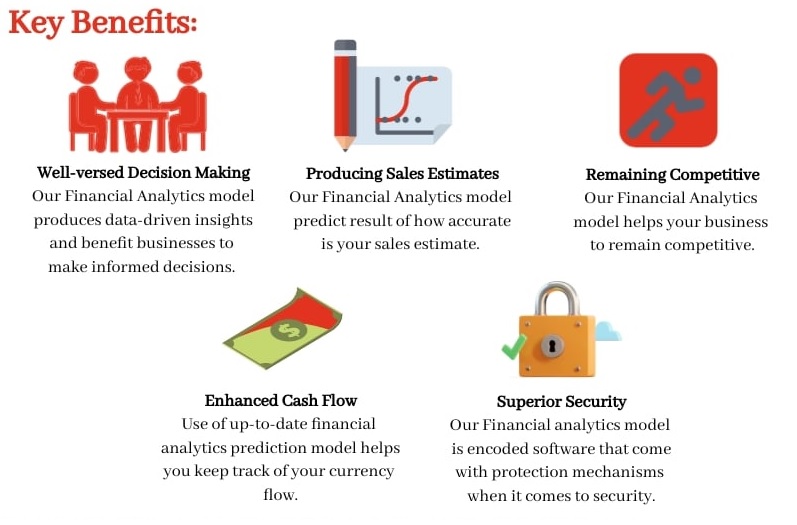Growing Role of Finance Analytics in Banking
With the rapid development of digital technology, banks have started to implement business analytics to automate their business processes, maintain customer satisfaction, and drive revenue.
If ever there’s been a sector where analytics could play a stellar role, it’s banking. Data is something that banks have been dealing with for ages, and its scientific analysis can help them bring about major performance improvements, leading to a boost in their bottom lines.
What is Finance Analytics?
Financial analytics, also branded as finance analytics, offers different perspectives on the financial data of an assumed business, providing insights that can simplify strategic decisions and actions that increase the whole performance of the business.
Where can be Financial Analytics used?
The first place that analytics can be used is in serving the customer. Today, top of the customer pyramid is the millennial generation whose idea of banking is far different from those of its predecessors. Statistics show that millennials will surpass ‘Baby Boomers’ in 2019.
There are about 90 million millennials in just the USA alone, representing a collective buying power that runs into trillions annually.
So it’s obvious that for banks to survive, they need to cater to this segment, which means adapt.
They need to dump the old money management mindset and techniques to better connect with this customer base.
Which means, smartphone apps, smart credit cards, and so on. And this also means introducing finance tech technology including behavioral analytics to “know your millennial customer”.
Financial apps are slowly but irrevocably replacing the bank teller or bank officer at one level, simultaneously helping banks to reduce operational costs.
Interested in knowing how the Financial Data Analytics benefits your business? Speak to Our Experts
Invariably, when banking and analytics are spoken of in the same breath, the reference is to use data analytics for:
- Customer experience
- Compliance
- Risk Management
- P&L
World over, banks have been under great pressure. More so, in the US, after the financial crisis in 2008, banks have started looking at retail for growth, so adding value to a customer’s experience is a top priority.
A standard, ‘catch-all’ marketing policy, for example, is no longer enough. Banks have woken up to the fact that they need to “know” their many customers at a granular level.
How? By relying on the vast amounts of data they collect on them, almost daily.
Analysis by humans a few years ago was next to impossible, but today, with Fintech, this data can be analyzed to reveal their habits, preferences, and needs, leading to a better engagement between bank and customer.
Streamline your cash flow and enhance operational efficiencies using our financial analytics solution
Most banks have realized that they have no option but to change. Evidence of this was in a recent McKinsey survey that found that almost every bank had advanced analytics among its top five priorities.
The report also pointed out a pertinent issue – a few banks that had gone down that route had already starting reaping rich dividends.
This motley group had invested in data analytics tech by establishing data lakes and centres of excellence and using machine learning (ML) techniques.
Why is Financial Analytics Important?
Financial analytics benefits in shaping up futures business goals. You can also develop the decision making strategies of your business with the help of Finance Analytics.
Financial analytics provides in-depth insights about the financial position of your business and increase the productivity, cash flow and worth of your business.
Customer Experience
It’s all about the customer, customer, and the customer. Analytics can be used for customer segmentation.
After all, banks do have all kinds of customers with different financial behaviors and requirements.
Using Big Data, banks can segregate clients based on their demographic profiles, behavior, including buying or investment patterns.
Such segmentation will benefit the banks when it comes to marketing promotions to target audiences, and also to help build better customer relationships.
It does not end there. Banks can study the spending patterns of their clients, and using predictive analysis, for example, identify when potential customers may require certain financial services.
As a first step, banks do not need to invest in costly finance analytics platforms that require experts from the “outside”.
A Harvard Business Review white paper found that 62% of organizations required others within their firm to perform some steps in the analytics process, resulting in 69% not being satisfied with the quality of the output and 81% not being satisfied with the speed of the output.
Clearly, dependence on data scientists and specialized staff for data preparation and analytics is not everybody’s cup of tea. The answer lies in self-service data analytics tools.
Such tools can be deployed at the departmental level, where bank employees themselves can be trained to operate them.
Sharing the departmental banking data analytics within the organization on a day-to-day basis will help the bank get a 360-degree picture of all customer interactions to effectively target customers.
Risk Management
Another very important area where finance analytics is already playing a role is in risk management in banks/banking. Risks come in many forms – bad loans, fraudulent activities, or investments that have flopped.
Of late, global banks have been under great strain due to increased competition from non-banking players, low asset yields, and an increase in commercial borrowings.
All these factors represent a percentage of risk for the bank, and early detection of these risks can help a bank prevent a major loss.
After all, as competition for borrowers intensifies, banks tend to underwrite a greater number of loans to companies with looser lending restrictions.
Analytics can play in helping to mitigate risks.

To sum it up, while clear evidence exists that at the ground level, banks have started veering to finance analytics/financial analytics to keep their flag flying and their ship from getting mired in debt, there are still major improvements needed.
Too many banks continue to save their data in silos, spread across various customer touchpoints like an app or an ATM.
Information and its subsequent analytics need to be amalgamated and then shared to allow line account managers and product leaders to obtain a complete view of customers – retail and commercial – to better assess the risks associated with individual customer activities and portfolios.


No comments yet.